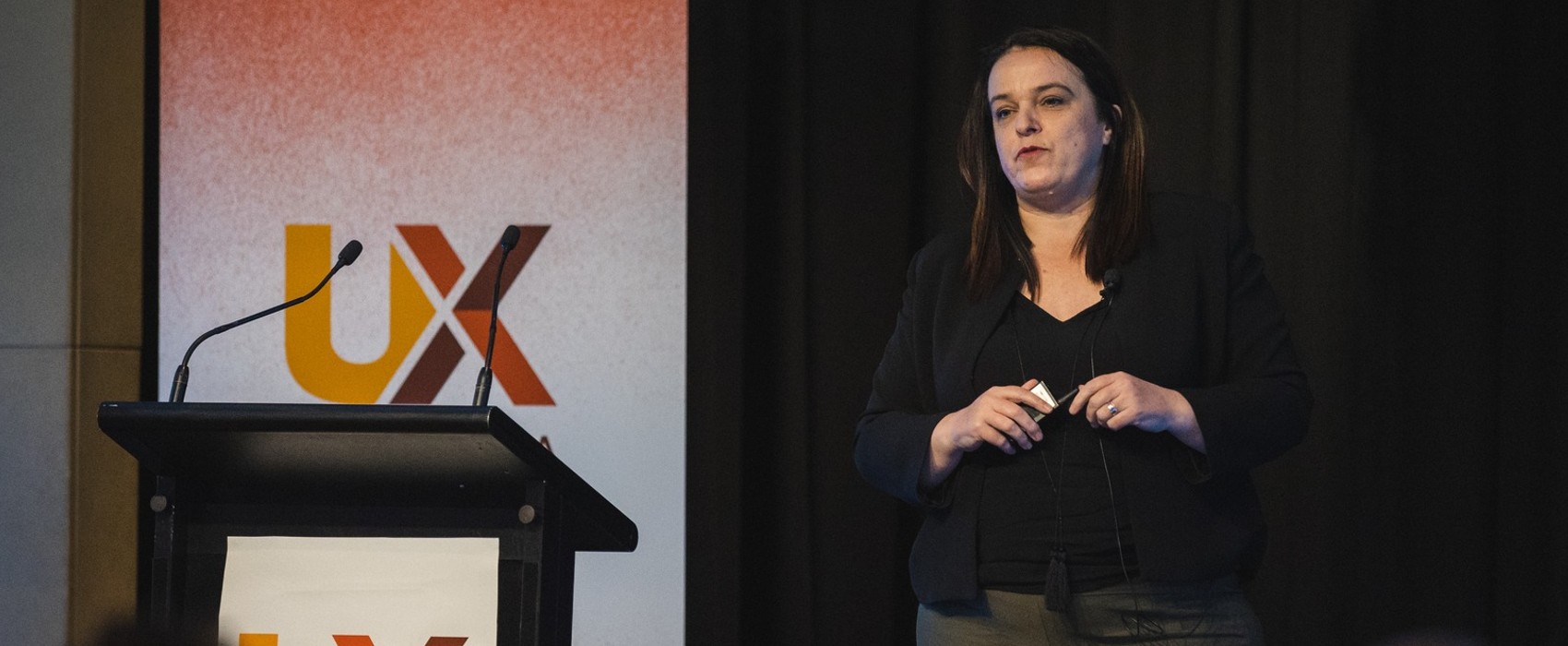What does it mean to design services in sensitive areas? Firstly, sensitive is a word that gets used in many contexts. I’m not talking about classified information or people who are easily offended.
We all experience life differently—what makes something sensitive is whether it has the potential to impact your wellbeing. Approaching this work requires not only empathy, but a deep level of humility and appreciation of the precariousness of life.
I had the pleasure of presenting at UX Australia 2022 and took the moment to reflect on what it means to design services in sensitive areas. These are four of the principles I shared, drawn from my 20 years of working with communities including older Australians, refugees, and victims of crime, and in areas such as mental health and bereavement.
 Liquid's Head of Strategy Fiona Armstrong speaking at UX Australia 2022
Liquid's Head of Strategy Fiona Armstrong speaking at UX Australia 2022
1. Start by seeing people, not labels
First, we need to approach our work with the right mindset. Our vulnerabilities, and those of our users, are not generic, can change over time, and they don’t look the same in everyone.
It’s easy—especially in a government context—to put labels on people, grouping them by culture, disability, religion, or sexual orientation. However, designing in sensitive areas is not a box-ticking exercise.
Instead, we need to see the person we are working with for who they are. We need to develop an ability to understand what we’re hearing, or perhaps not hearing. Sometimes, what we don’t hear is the biggest clue as to where we can make a difference.
2. Move beyond empathy
Working in sensitive areas is about seeing things from our users’ point of view and imagining ourselves in their place. Deep empathy is critical but we need to go beyond that. Without understanding their ‘why’, our solution won’t create long-lasting change or improved outcomes.
A good example of this was listening to a group of young African refugees who were struggling to adjust to working life in Australia, I realised this was tied to their fundamental life experiences. Having grown up in refugee camps, the notion of waking up to an alarm clock, going to work at a certain time and staying there, was so far removed from their view of normal. This insight helped me understand perceptions of time through their eyes and get to the heart of the problem we needed to solve.
3. Remember to protect your personal resilience
When we are focused on empathy, it can be easy to lose sight of the importance of looking after ourselves, especially when working in sensitive areas.
There are scenarios where our personal resilience may be challenged:
- Listening to participants’ lived experiences can be challenging. If people have been recounting their trauma to you, it’s reasonable to expect becoming upset or being overwhelmed. Work within your team to support one another and take opportunities to purposely decompress.
- If you’re working as part of government, participants who have had difficult or unpleasant experiences with government agencies may convey their anger and frustration to you. It's important to remember their comments aren’t directed at you. In this situation, work to understand why they have this anger because it's valid and may prove insightful.
- With our knowledge of services and agencies, sometimes we may be tempted to offer advice to participants. After all, it’s our empathy that brought us to this work in the first place. However, it’s important to maintain professional distance and resist the urge to help. Our job in that moment is just to listen. We should, however, ensure appropriate professional support and information are available for participants after their session.
4. Ethics and governance matter
Strong principles around research ethics are essential and always baked in from the start. Depending on how sensitive the topic is—how big the risk is for participants—more advanced levels of ethics apply.
Research ethics are governed by the National Statement on Ethical Conduct in Human Research, which details the need to do the right thing, in the right way, with respect and concern for your participants. It emphasises that your research must have merit, integrity and justice, and benefit to the people you’re engaging.
Within those national guidelines, institutions will often have their own guidelines and ethical review processes. It’s worth checking whether your work will trigger their ethics review process. Failing to do so could mean significant project delays.
Another important consideration in delivering an ethically robust project is governance to ensure appropriate outcomes are created for users. At Liquid, we work on large projects that deal with mental health and aged care. Reviews of the clinical appropriateness of product, tools, and content take place throughout each project. Being able to find the balance between clinical and user needs and expression takes time, compromise and understanding. Getting it right is critical.
Liquid is a principal sponsor of UX Australia this year! We’re excited about connecting with the design community and sharing insights from our work and practice.
